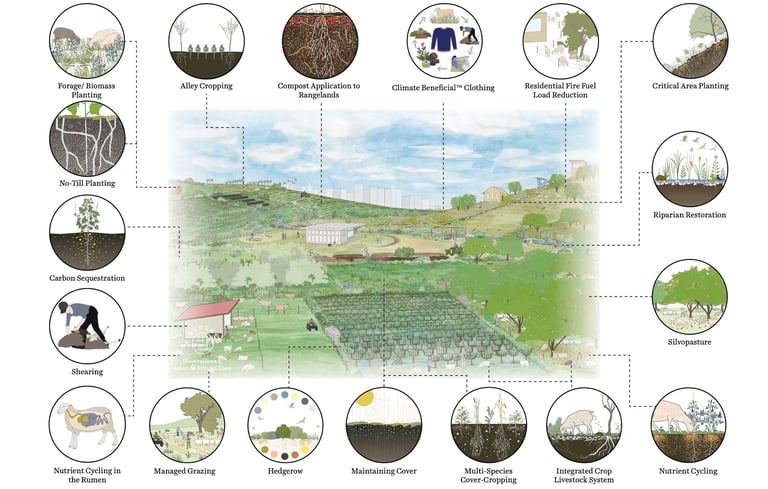Carbon Farming
Turning Farms into Climate Solutions As the world grapples with the escalating impacts of climate change, agriculture stands at a crossroads. While it is one of the sectors most vulnerable to climate disruptions like droughts, floods, and heatwaves, it also holds the potential to be part of the climate solution. This is where carbon farming comes into focus—a transformative practice that helps farmers capture carbon from the atmosphere and store it in soil and plants, while improving land productivity and resilience. In India, where millions of farmers depend on fragile, climate-sensitive ecosystems, carbon farming offers a double benefit: supporting climate action and enhancing long-term agricultural sustainability.
HawkEye
5/15/20252 min read


What is Carbon Farming?
Carbon farming refers to agricultural methods designed to sequester atmospheric carbon dioxide (CO₂) in vegetation and soils. Unlike conventional farming, which can release large amounts of carbon into the atmosphere through plowing, burning, and overuse of chemicals, carbon farming reverses this trend by:
Storing carbon in biomass and soil organic matter
Improving soil health and structure
Enhancing biodiversity and water retention
It is part of a broader approach known as climate-smart agriculture, complementing practices like drought-resistant crops and AI-based climate prediction.
Techniques Used in Carbon Farming
Several science-backed techniques are currently being adopted across the globe—and many are highly relevant to Indian conditions:
1. Agroforestry
Integrating trees with crops and livestock systems helps capture carbon while also providing shade, fodder, and fruit. Popular in tribal and dryland regions of India.
2. Cover Cropping
Growing cover crops like legumes during off-seasons improves soil carbon and prevents erosion.
3. Reduced Tillage / No-Till Farming
Minimizing soil disturbance helps retain carbon in the soil and reduces CO₂ emissions.
4. Biochar Application
Adding biochar (a form of charcoal made from crop residue) to soil locks in carbon and boosts soil fertility.
5. Organic Amendments
Using compost, cow dung, green manure, and vermicompost enriches soil organic matter and sequesters more carbon.
6. Rotational Grazing
Well-managed grazing systems allow pastures to regenerate, enhancing soil carbon and reducing land degradation.
Benefits of Carbon Farming for Indian Agriculture
Improved Soil Health
Soils enriched with organic carbon retain more moisture and nutrients—critical for drought-prone areas.
Climate Resilience
Carbon-rich soils are better equipped to handle temperature extremes and rainfall variability, which is increasingly common due to climate change.
Potential for Carbon Credits
Farmers engaging in verifiable carbon farming practices can earn income through carbon credits, which are purchased by companies aiming to offset emissions. This emerging market can provide a new revenue stream for rural households.
Higher Yields Over Time
Improved soil structure and fertility support more consistent and sustainable crop production.
Environmental Impact
Carbon farming helps reduce greenhouse gas emissions, supports biodiversity, and improves air and water quality.
Integration with Modern Technologies,Carbon farming is even more effective when paired with digital tools:
AI-powered climate prediction models guide farmers on optimal sowing times and weather-sensitive techniques.
Remote sensing and satellite data can track carbon sequestration progress at field level.
Soil carbon monitoring apps help farmers evaluate the impact of practices over time.
These innovations make carbon farming measurable, verifiable, and scalable, even for smallholders.
Opportunities:
Government support under schemes like Paramparagat Krishi Vikas Yojana (PKVY) and National Mission for Sustainable Agriculture (NMSA)
Collaborations with agri-tech platforms for field-level advisory and monitoring
Public-private partnerships to link farmers to carbon markets
Conclusion
Carbon farming represents a powerful intersection of agriculture and climate action. For Indian farmers, it offers a path to not just survive climate change—but to become stewards of the solution. By adopting these practices, they can improve yields, restore soil health, and potentially unlock new income streams, all while contributing to a healthier planet.
With the right support, education, and technology, India's farms can become carbon sinks—absorbing carbon, growing sustainably, and leading the way toward a more resilient agricultural future.
